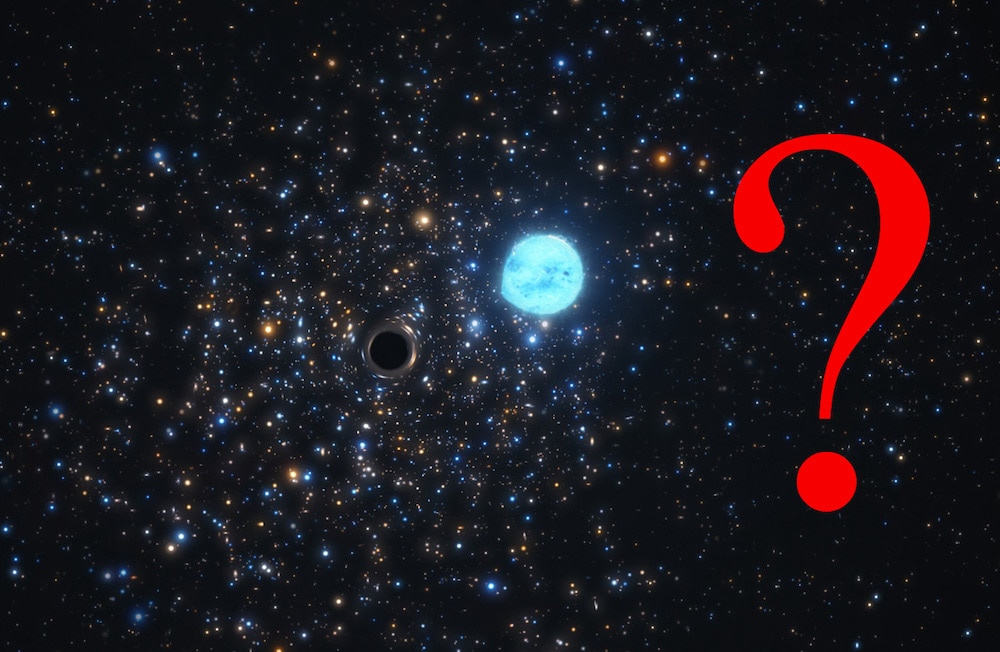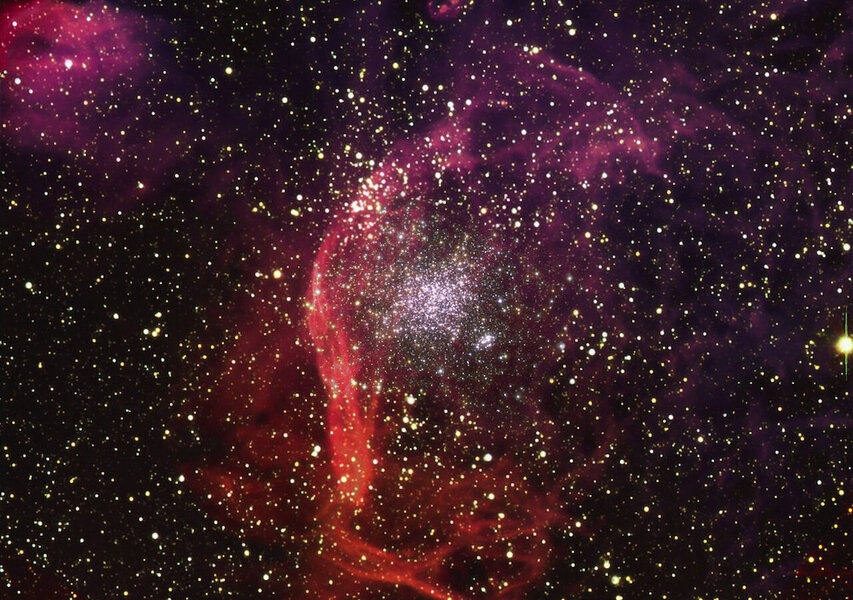Create a free profile to get unlimited access to exclusive videos, sweepstakes, and more!
So, about that black hole found in a nearby galaxy… yeah, maybe not so much
Black hole findings called into question.

Just a week ago, I wrote about research claiming to have found a black hole in a nearby galaxy based on observations of a star orbiting it.
Yeah, that may not be the case. Just days after the first paper came out a different team of astronomers shows that the second object may be a relatively normal star, and not a black hole.
Bummer.
To refresh your memory, NGC 1850 is a young (100 million years old) star cluster in the Large Magellanic Cloud, a satellite galaxy to our Milky Way. In it is a star the first team called NGC 1850 BH1. The observations showed this star was orbiting an unseen object at 140 kilometers per second* with a five-day period. The visible star (let's call it the primary) was variable in brightness, consistent with it being a teardrop shape, expected when a star closely orbits a black hole, and they inferred its mass being about 5 times the Sun's. The only way this could all work is if the second object (the secondary) is a black hole 11 times the Sun's mass.
This all comes down to a critical observation about the evolution of the star. When a massive star starts to run out of fuel in its core, the outer parts swell up. That changes the color of the star, and this can be used to determine many things, including its mass.
The first team assumed this was a normal star, if somewhat more massive than the Sun, and used its colors to determine it was about 5 times the Sun's mass. Given the orbit, the mass of the star, and other characteristics, this led them to the conclusion that the second object was a black hole.
But what if it's not a normal star?
The second team looked at the orbit and came to a different conclusion.
If it's orbiting closely around another object (whether it's a black hole or another normal star) near the end of its life the primary star can't just get bigger; the gravity of the other object will start to draw material off the primary star if it gets to a certain size. The primary becomes distorted, more teardrop-shaped than spherical, with the tip of the teardrop pointed between it and the secondary object.
The size the primary can get to before overflowing onto the other star is called its Roche lobe, and that defines the teardrop shape. If the primary is in a five-day orbit around the secondary then the Roche lobe is pretty small, and it's very likely the primary star filled it. That means it could've lost a lot of mass, dumping it onto the other star. That changes the color of the primary as well.
What the new works shows is that the way the first team got the mass is not likely to be correct. The first team's method gives you the temperature and size of the star, but not its mass. The second team used a different method to get the mass, a well-known relationship between a star's density and orbital period if it fills its Roche lobe (needless to say, a lot of complicated physics is behind this, but it's a pretty dependable relationship). The bottom line is they can get the density of the star and its radius, and that in turn yields its actual mass.
The mass they find is a lot less than the first team did: They get it between 0.65 to 1.65 times the Sun's mass, not 5 times.
That's critical. If the primary star is less massive, then the secondary has to be as well to give the orbital characteristics measured. They find a more realistic mass of the secondary object is closer to 3.5 times the Sun's, possibly as much as 5.
That doesn't rule out a black hole — they can be as low as 5 solar masses — but it makes it a lot less likely. Also, if the primary is dumping material onto the secondary, as it likely is, that material should get very hot and emit X-rays as it falls into a black hole. However, almost no X-ray emission is seen. That does happen sometimes with black holes, but is pretty unlikely.
So it just makes more sense all around that the primary is lower mass and the secondary is just a normal star. They think the pair likely started out with something more like 4.8 and 3 times the Sun's mass. When the first star started to die it dumped material onto the other star, losing its outer layers (and the secondary couldn't take in all that material, so some was tossed away, lost to space). Over time the first star lost mass and the second gained it, such that the primary is now much lower mass, basically the exposed core of a normal star.
All in all, their explanation makes sense. It provides an easier evolutionary pathway and explains more simply why no X-rays are seen. There's no black hole there to make them.
But there's more! A couple of other times people have thought they've found stellar-mass black holes (ones with 5 – 100 times the Sun's mass) orbiting normal stars, and both times it turns out to be a situation more like this one, where the second object was just a normal star orbiting the other (one was thought to be the closest known black hole to Earth before it was shown not to be one at all, and another system where one object was thought to be an overmassive black hole but is more likely much lower mass, if it's even a black hole at all). All three cases have similarities, and the second team points out these can easily lead to a mistaken assumption that one of the objects is a black hole.
We usually find black holes because they're actively feeding and blasting out X-rays; it tends to make them obvious and unambiguous. This method, looking at the orbital motion of a normal star around the black hole, is much tougher, and prone to misidentification. It's still possible this case of NGC 1850 BH1 is a black hole, but it's far less likely now.
While discouraging, it's all for the best if this turns out to be the case! When we're trying to discover new things we have to know that what we're doing isn't wrong. A negative result isn't a bad thing, because we still learn something. It may not be as glamorous as finding a black hole, but every time we find out something new it's a good thing.
*In my original writeup I said it was 300 km/sec, a mistake on my part.




























